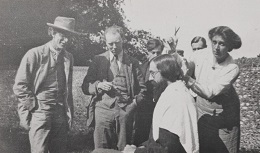Art course on twentieth century British Modernism
Yesterday it was back to school at my local learning centre for an art course on twentieth century British Modernism. Our excellent teacher believes British twentieth century art to be underrated and this is one of her themes. She prepares us well for the course, distributing a time-line chart of developments in politics and society, science and technology, culture and art in the 1900s and 1910s and what two eventful decades they were. There were a number of influences on art – photography and film, plus colonialism which generated an interest in naive tribal art, a huge inspiration for Picasso.
Art was moving from rich patronage to a more critic/dealer culture.
 Two of the most influential critics of the early twentieth century were Clive Bell, married to Virginia Woolf’s sister Vanessa, and Roger Fry who coined the description post-Impressionism though not many British painters were at the vanguard of it.
Two of the most influential critics of the early twentieth century were Clive Bell, married to Virginia Woolf’s sister Vanessa, and Roger Fry who coined the description post-Impressionism though not many British painters were at the vanguard of it.
Many, however, were members of the New English Art Club which still exists today and lived and worked in France in Paris or Dieppe.
Galleries too were becoming more important. The Sackville gallery’s exhibition of Marinetti attracted an incredible 40,000 visitors in 1912.
 The first decade also witnessed the most important picture of the twentieth century Les Desmosielles d’Avignon by Picasso in 1907, though not seen publicly until 1916 when it received critical dislike .
The first decade also witnessed the most important picture of the twentieth century Les Desmosielles d’Avignon by Picasso in 1907, though not seen publicly until 1916 when it received critical dislike .
I have studied it many times and not especially liked it though recognising its importance for revolutionising form, composition and perspective. Until now I never appreciated the still life fruit that appears below the figures. The aggressive glare of the three prostitutes may have been generated by Picasso’s sexually contracted illness but certainly the faces of the men on the right reflect the artist’s tribal art inspiration
I did not also know that Picasso contracted a form of syphilis in 1905 and was terrified be would lose his sight. It was daring for its subject matter of prostitutes and one can imagine that those that derided safe chocolate boxy Victorian art heralded it.
 One who did not, and symbolised the more Victorian style was the President of the Royal Academy Sir Alfred Munnings, who at at an RA dinner when he was the worse for wear famously dismissed Picasso.
One who did not, and symbolised the more Victorian style was the President of the Royal Academy Sir Alfred Munnings, who at at an RA dinner when he was the worse for wear famously dismissed Picasso.
This tension between figurative and abstract art has been a battle waged in British art circles throughout the twentieth century.
British twentieth art is hard to classify.
We don’t do “isms” here and the only movement that Britain dominated was Pop Art whose founder was Richard Hamilton. Stanley Spencer, Howard Hodgkin, Francis Bacon and Lucian Freud were sui generis.
It’s truly admirable that such courses exist and that our teacher conducts them with such enthusiasm and knowledge.

